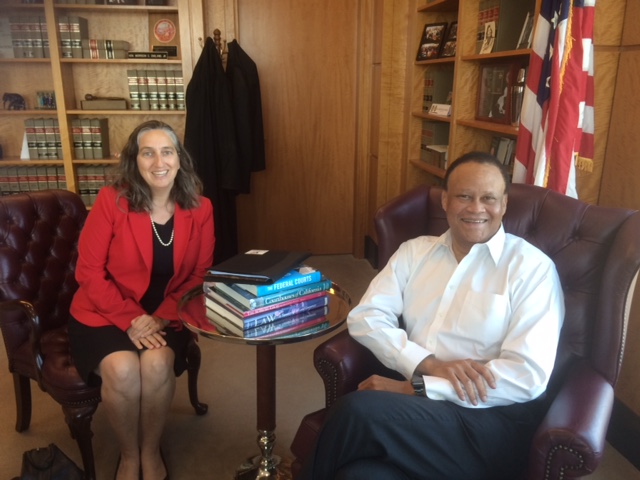Every election year, McGeorge Associate Dean Mary-Beth Moylan teaches the California Initiative Seminar. In it, students analyze every Proposition on the California ballot. That work culminates in the publishing of the California Initiative Review, the California Initiative Review – Initiatives At-A-Glance, and the California Initiative Forum. All of these resources are made available to the public, for free. Individual analyses of each ballot initiative can also be found on the California Initiative Review page on McGeorge’s website.
In normal years, the Initiative Forum would have been held in person. This year, to protect the health of everyone involved, the forum was held entirely online and live-streamed on October 21. Below is the recording of the live stream. Some questions we were able to answer live, and you can watch or listen to those questions and answers in the video below. Some questions we did not have the opportunity to answer verbally. Those questions and answers are listed out below and organized by Proposition. Not every initiative had questions that received written answers.
Proposition 14
Q: Why isn’t the stem cell research left to the private sector?
A: One argument – Private sector investment generally occurs during the testing and development phase, rather than the initial basic research. Scientists have referred to the stage right before industry becomes interested in the research as the “Valley of Death.” It is an area where promising therapies often languish because there is not enough federal funding to push the projects through to the later stages.
FAQ, CIRM CALIFORNIA’S STEM CELL AGENCY, https://www.cirm.ca.gov/about-cirm/cirm-faq#funding
Q: Does California spend a lot of money on medical science-related initiatives that end up as a proposition in a ballot or is Proposition 14 an anomaly?
A: Proposition 14 is not an anomaly. We have had other initiatives to fund science-related initiatives. That said, it is definitely within the legislative prerogative to use general fund dollars to fund science initiatives so that we do not need to vote on them.
Proposition 15
Q: On Prop 15: Wouldn’t the $3 Million Dollar kick in floor incentivize property owners to simply “shell off” to other folks they know letting them retain control without ownership in name? Is there a loophole there?
A: That is a current loophole- if the property is not sold it does not get reassessed. Under the new assessment, every property that qualifies is reassessed every 3 years regardless if ownership has changed hands. There is a provision within Prop. 15 that might address this situation. This section also states that any related entities are one taxpayer, thereby not allowing independently managed and operated businesses to qualify for small business exemptions if they are related to a business that does not qualify as a small business. Cal. Proposition 15 at §7(b). However, California Assessors’ Assoc. (CAA) has noted that this is going to require coordination between counties that does not exist and require a staffing increase of about 1,000 more assessors. It should be noted that CAA has testified against Prop. 15 for these reasons and other reasons.
Q: Since prop 15 has a negative impact on farmers and ranchers, is it likely we will see a trickle effect in the entire food chain (ie higher food prices)?
A: This is one of the opponent’s arguments. They fear a trickle-down effect on consumers. It is possible, but I don’t think there is any hard evidence that this will happen.
Q: Has anyone seen any studies that quantify the economic effects on the state, of all of the businesses and investors and revenue generators who will add to the stream of such parties leaving California for lesser-taxing states, if this proposition passes?
A: There have been multiple studies looking into this. However, I am not aware of a study that was done since the pandemic began and therefore considers the current economic environment. We cite a few studies from the proponents and opponents in our paper. Measuring the validity of the studies is slightly outside of the scope of our analysis. Therefore, I cannot make a statement on the validity of these studies or what studies are seemingly more reputable.
Proposition 17
Q: If passed, would payment of restitution have any bearing on a parolee’s ability to vote?
A: Under the language of Proposition 17, restitution does not play into re-enfranchising parolees. While speaking with the proponents of the initiative, it was made clear that they do not expect a challenge like what happened after Amendment 4 passed in Florida during the 2018 midterms.
Q: You note there are some parolees that would still not be able to vote. Can you clarify who these individuals would be? Sexually violent predators? Other violent crimes? White-collar crimes?
A: If passed, all parolees would be allowed to vote so long as they meet the other requirements for voting that everyone else is held to (i.e. at least 18 years of age, California resident, U.S. citizen).
Proposition 18
Q: Isn’t it inconsistent to say 16-17-year-olds are mature and sophisticated enough to vote and determine the fate of millions of Californians, but not mature or sophisticated enough to purchase cannabis or tobacco? How can the state consider someone a juvenile until age 24 for purposes of criminal justice, but an adult for purposes of voting at age 17?
A: The opponents of the measure are making those arguments. We already have 18-year-olds voting and this would only allow those who will turn 18 by November to vote in primaries in March or June. It is a minor adjustment to existing law. Reasonable minds can disagree about whether we have as a society has placed our age limits in the correct spot for all sorts of rights and responsibilities.
Proposition 19
Q: How are renters or first time buyers disadvantaged by this proposition?
A: Opponents argue that because early purchasers (meaning long-time homeowners) will be re-entering the market with more purchasing power than first-time buyers or renters, first-time buyers and renters will be put even more at a disadvantage in the market. The purchasing power that the long-time homeowners would have include capital and experience. In other words, the opponent’s argument is essentially that there will be more goliaths entering the market, rendering first-time purchasers and renters uncompetitive in comparison.
Proposition 22
Q: If the exemption is not passed, would new hires or drivers have longer onboarding times during hiring? My concern is that people who are losing their jobs during the pandemic that are falling back on these gig jobs would have the carpet pulled out from beneath them.
A: Courts required Uber and Lyft to create a plan that implements compliance with AB 5 in case Prop 22 does not pass. I do not think the answer to your question is a known fact, but in practical terms that seems like a very reasonable concern (especially given network companies’ arguments against complying with AB 5). Again, however, network companies are legally required to have a plan in place to comply with AB 5.
Q: Do app-based drivers tends to lean towards favoring or disfavoring passing Prop 22?
A: There are conflicting polls from each side and criticized by each side for their methodology and/or bias. Many ads quote these polls, but it’s not clear what their reliability is.
Q: In the discussion of Prop 22, I think it was mentioned that it repeals AB 5. Is this the case? Or does Prop 22 only cover app deliver and drivers, and AB 5 would still cover the other workers that it did before?
A: Prop 22 overrides AB 5 as it applies to app-based drivers only. AB 5 would remain in place for other industries.
Q: How does prop 22 compare to existing exceptions to AB 5?
A: Proposition 22 solely applies to app-based drivers. There is the potential that other industries would adopt this classification model of their employees.







